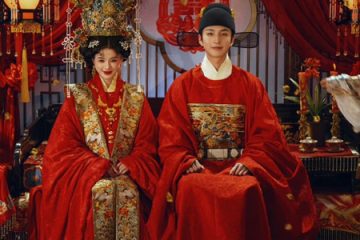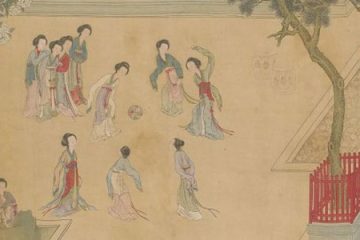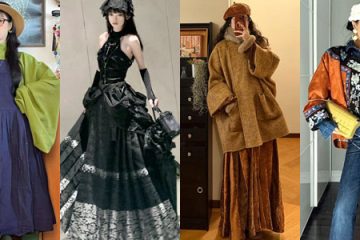Comparing Hanfu in Different Painting Styles: Traditional Chinese Ink Painting vs. Western Oil Painting

Cultures around the world have various ways of interpreting their own civilizations, and painting is one of the key methods of expression. In China, traditional painting is referred to as guohua (Chinese traditional painting), a term that originated during the Han Dynasty. It primarily refers to scroll paintings created on silk, rice paper, or fabric, using a brush dipped in water, ink, or color pigments. In contrast, oil painting is a Western art form where pigments are mixed with fast-drying plant oils and applied to surfaces such as canvas, cardboard, or wood panels. In this blog, we will explore the differences in the portrayal of Hanfu in guohua and oil painting, examining how each style reflects the unique cultural aesthetics of China and the West.
I. Guohua
Elements of Linework
Chinese ink painting places great emphasis on the organic combination of key visual elements such as dots, lines, and planes. When it comes to depictions of people, lines are the primary element used in the artwork. However, the style of these lines has varied significantly across different historical periods in China. In Chinese painting, techniques like point perspective are often employed, which give the figures a two-dimensional appearance. For example, during the Qin and Han dynasties, there was already a focus on the beauty of lines in clothing. By the Tang Dynasty, the use of lines in fashion design became even more pronounced, with lines taking center stage in everything from decorative patterns and prints to the perfect pairing of pibo (long, flowing piece of cloth or silk draped over the shoulders) and garments. Straight lines, curves, long lines, and short lines all came together in a harmonious design.
Vivid vs. Light Colors
In Chinese ink painting, color is primarily expressed in two forms: vivid colors and light colors. The Tang Dynasty was the most prosperous period for vivid color painting, particularly in depictions of figures. Many ancient caves, such as the Dunhuang Mogao Caves and the Maijishan Grottoes, employed vibrant colors to create their murals. Vivid color paintings are characterized by rich, bright hues and strong contrasts. During this period, detailed and elaborate paintings of noble women using heavy colors were abundant and of high quality. In contrast, the Song Dynasty favored lighter colors, influenced by the Neo-Confucianism of Cheng-Zhu school of thought, which led to a gradual shift away from vivid color usage in favor of more subdued tones.
Techniques in Figure Painting
Chinese figure painting can be divided into three main styles based on technique: gongbi (meticulous), xieyi (freehand), or a combination of both. These styles can be understood as varying levels of complexity, from detailed and intricate to simplified and moderate.
1. Gongbi Painting
Gongbi painting is known for its complexity and precision. A prime example of this style is Gu Kaizhi’s “Lochshen Fu” (洛神赋图), a masterpiece of meticulous painting from the Eastern Jin Dynasty. This style is characterized by fine details and intricate designs. During this period, Hanfu garments were equally detailed and luxurious, with each intricate feature vividly depicted. The viewer can almost feel transported back in time, experiencing the beauty of the layered and elaborate Hanfu of that era.

2. Xieyi Painting
In contrast to the meticulous style of gongbi, xieyi painting is more fluid and free-spirited. A notable example is Liang Kai’s “Taibai Xingyin Tu” (梁楷《太白行吟图》), which excels in simplicity and brevity. With just a few strokes, Liang Kai captures the essence of the poet Li Bai in a vivid and dynamic way. His technique does not focus on minute details of the figure, but instead, through swift, flowing brushstrokes, he conveys the poet’s character and spirit. The painting offers a evocative depiction of Li Bai, capturing his expressions, without any over-refinement or artificiality.

3. Combination of Both Styles
Shen Zhou (沈周), a prominent painter of the Ming Dynasty, was skilled at combining both intricate and simplified techniques. He applied the “intricate” method to clothing, decorating garments with various techniques that made them appear as light and flowing as the embroidered robes (绣衣) of the Qing Dynasty. This fusion of detailed and free-flowing styles allowed the clothing to maintain an elegant, flowing quality.

Another example of combining both painting techniques can be seen in the *”Portrait of Zhang Qingzi”* (《张卿子像》) by Ming Dynasty artist Zeng Jingming (曾鲸明). In this painting, the features of Zhang Qingzi’s deep robe are clearly depicted, reflecting the simple and practical nature of Hanfu. The figure’s face is rendered with meticulous *gongbi* technique, capturing the essence and spirit of the character. The clothing, on the other hand, is portrayed with a flowing and graceful quality, objectively representing the attire of scholars at the time. The overall composition of the painting is simple yet elegant, conveying a refined and dignified appearance.

II. Oil Painting
As an imported art form, oil painting has now developed into a genre that stands alongside traditional Chinese painting. While oil paintings featuring Hanfu as a subject are relatively rare compared to Chinese ink paintings, there are still many remarkable works worth discussing.
For example, scholar Chen Yiming from Southwest University for Nationalities has compiled oil paintings with “Hanfu” elements by notable artists such as Xu Beihong’s “Tian Heng and the Five Hundred Warriors” in 1928 (徐悲鸿《田横五百士》), Wang Gansheng’s “Portrait of Li Shizhen” (王干生《李时珍画像》), and Tian Xiaoping’s “Lotus Charm” (田小平《荷韵》). However, in some works, such as those by Tian Xiaoping, we can only vaguely recognize features like the “quju”, “zhijiu”, and “ruqun” (chest-high skirt). Still, the garments in these paintings often suffer from exaggerated distortions and lack the true essence of Hanfu’s form.
Quju robe has a right-side collar that wraps around the back, which is why it is also known as the “quju shenyi” or “wrapped-collar shenyi.”
Zhijiu robe features a straight-cut lower garment, with the hem hanging at the side or slightly behind the body, and the upper and lower parts of the garment are connected.
1. Tian Heng and the Five Hundred Warriors
The image below is Xu Beihong’s Tian Heng and the Five Hundred Warriors, which depicts a scene from the Records of Historian Tian Dan Liezhuan (《史记·田单列传》). It shows Tian Heng (田横), the leader of a peasant uprising, being escorted by 500 of his warriors after Liu Bang’s rise to emperor. While some of the figures are shown partially bare-chested, the detail of their hair tied into a bun clearly reflects the influence of Hanfu, with its distinct clothing, headgear, and hair accessories, demonstrating the deep cultural impact these elements had on the Han people.

2. Dance Music · Bells · Ancient Sound
Tu Zhiwei’s Dance Music · Bells · Ancient Sound is inspired by court lady figures from the Qin and Han dynasties, vividly portraying the classical elegance of Eastern dance and music culture. The painting captures the precise and unique details of the clothing design, with the dancers’ graceful movements and the musicians playing the panpipes with a look of deep immersion. The scene vividly brings to life the atmosphere of ancient court music performances, offering a truly immersive experience.

3. Eastern Rococo
In addition to the Hanfu images depicted by Chinese artists, the works of American painter William McGregor Paxton also feature strong Eastern elements. His paintings often include Qing Dynasty Chinese clothing, ceramics, Chinese crafts, and other elements, giving his work a distinctive Eastern Rococo aesthetic. In the 18th century, European culture was greatly influenced by East Asian cultures, primarily from China, but also including Japan, Korea, and Southeast Asia. This cultural fascination was infused with European romanticized fantasies of Eastern aesthetics. Common Chinese motifs such as dragons, phoenixes, butterflies, flowers, and pavilions, along with the opulent and lavish style, satisfied the Western desire for the exotic beauty of the East. These works stand as strong evidence of the global admiration for Hanfu culture.


III. Conclusion
In the realm of guohua, there are numerous works depicting the Han people, many of which are famous worldwide and deeply appreciated by people from all over the globe. However, when compared to guohua, oil paintings with Hanfu as a subject are relatively fewer in number. Whether it’s the meticulous and realistic gongbi technique, which emphasizes likeness and intricate detail, the expressive and freehand xieyi style that highlights the artist’s individuality, or the oil painting techniques that contrast sharply with traditional Chinese painting, Hanfu always manages to radiate new vitality and color from different perspectives.



0 Comments